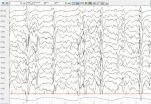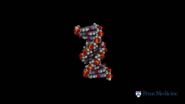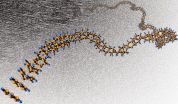(Press-News.org) LA JOLLA, CA—September 25, 2014—Scientists at The Scripps Research Institute (TSRI) have described how a single family of antibodies that broadly neutralizes different strains of HIV has evolved remarkably diverse structures to attack a vulnerable site on the virus. The findings provide clues for the design of a future HIV vaccine.
"In a sense, this antibody family takes more than one shot on goal in order to hit divergent forms of HIV," said Ian A. Wilson, the Hansen Professor of Structural Biology and member of the Skaggs Institute for Chemical Biology at TSRI.
"The findings give us new options for vaccine design," added TSRI Professor Dennis R. Burton, who directs the International AIDS Vaccine Initiative's (IAVI) Neutralizing Antibody Consortium and the National Institutes of Health-sponsored Center for HIV/AIDS Vaccine Immunology and Immunogen Discovery (CHAVI-ID) at TSRI.
The new research, reported in the September 25, 2014 issue of the journal Cell, is part of a broad effort to "retro design" an effective HIV vaccine, based on an understanding of rare, natural antibodies that effectively hit HIV's most vulnerable sites.
Decoys to the Immune System
Traditional viral vaccine design, which dates back hundreds of years, uses weakened or inactivated virus particles, or large viral subunits, to elicit long-term immune protection. But HIV, like some other viruses, thwarts this approach. It protects its vulnerable sites with a surface envelope protein (Env) that can mutate rapidly from strain to strain and coats its surface with covalently linked sugar molecules (glycans) that are hard for antibodies to grip.
Researchers have found, though that, in some HIV-infected people, the immune system does eventually penetrate the virus's glycan shield. It starts producing antibodies that can grab or at least block the virus's most vulnerable sites—sites that don't change much from strain to strain because they are involved in crucial functions such as docking or fusing with host cells.
These rare, "broadly neutralizing" antibodies are not usually produced in the body in high enough numbers to help already-infected people. But many researchers now are convinced that these antibodies hold the key to a successful preventive vaccine. Indeed, Burton's laboratory and collaborators reported recently that infusions of one such antibody, PGT121, protected monkeys from new infections with simian HIV and also dramatically lowered virus levels in already-infected monkeys.
Retracing the Immune System's Steps
The big challenge remains the "retro design": taking information about antibodies such as PGT121 and using it to design the main vaccine ingredient—the immunogen molecule—that can elicit high levels of the same antibodies in people. (Active vaccination to elicit a long-term protective response is far more feasible as a public health strategy than infusions of expensive antibodies would be.)
The new study highlights the complexity of that challenge. For the research, Burton's and Wilson's laboratories teamed up to characterize an antibody called PGT124, a recently discovered member of the PGT121 family.
Such families are the products of a powerful diversity-extending process in the immune response called affinity maturation. The B cells of the immune system produce a standard repertoire of millions of "germline" antibodies even in the absence of infection. But when one of those B cells encounters a matching target (such as a specific shape on a virus) and responds by becoming activated and replicating rapidly, its antibody-coding genes mutate slightly with each cell division. A family of not-quite-identical B cells and corresponding antibodies are generated that can potentially hit the same target more strongly and precisely—and also in different ways, hopefully blocking the ability of a virus to escape with mutations of its own.
No one has identified the germline antibody that develops into the PGT121 family. However, by studying its offspring, scientists can infer that original antibody's broad features—and structures a vaccine immunogen could display to stimulate the production of broadly neutralizing antibodies.
Surprise Findings
Previous studies had found that one branch of the PGT121 antibody family, PGT121-123, attacks a vulnerable site on HIV's envelope protein at the base of a hypervariable structure (called the V3 loop), grabbing relatively non-varying protein components and multiple glycans—with very low affinity for any single glycan.
In contrast, results from this study revealed that another member of the family, PGT124, from a different lineage, maintained its grip on the site by fastening to a small fragment of the viral protein plus a single glycan.
"Affinity maturation is a critical process of directed evolution in mounting an antibody response to all pathogens," said Fernando Garces, a postdoctoral fellow in the Wilson laboratory. "However, molecular details of this process have been unavailable. Now, through structural biology, we have elucidated at the atomic level how antibody maturation can pursue different strategies to recognize HIV-1 gp120, leading to broad neutralization of the virus. Initially, we had assumed that the PGT121 family has a complex epitope involving multiple protein pieces and many glycans.
"So when the crystal structure first popped out on my computer screen and I saw the antibody binding to a single glycan, my first thought was it was wrong," he continued. "Later we confirmed that the PGT124 antibody does indeed require only a single glycan and a few surrounding amino acids on the envelope protein to neutralize up to 70 percent of all HIV-1 strains."
Devin Sok, a research associate in the Burton laboratory, added, "This gives us better detail on how PGT121 family antibodies have diverged during the affinity maturation process—it's clear that there are multiple pathways, even within a single antibody family, to achieve broad neutralization of HIV. That's important to understand for vaccine design for HIV, as well as other glycan-shielded viruses such as influenza and hepatitis C virus. It's also relevant to the problem of targeting glycan structures on cancers and other diseases."
INFORMATION:
Other contributors to the study, "Structural Evolution of Glycan Recognition by a Family of Potent HIV Antibodies," were Leopold Kong, Ryan McBride, Helen J. Kim, Karen F. Saye-Francisco, Jean-Philippe Julien, Yuanzi Hua, Albert Cupo, John P. Moore, James C. Paulson and Andrew B. Ward, all of TSRI.
The study was supported by the International AIDS Vaccine Initiative Neutralizing Antibody Center; by the Center for HIV/AIDS Vaccine Immunology and Immunogen Discovery (UM1 AI00663); by the HIV Vaccine Research and Design program (P01 AI832362 and R37 AI36082); by the National Institutes of Health (RO1 GM046192, R01 AI332932); and by the Joint Center for Structural Genomics, which is funded by the NIH NIGMS Protein Structure Initiative (U54 GM094586).
About The Scripps Research Institute
The Scripps Research Institute (TSRI) is one of the world's largest independent, not-for-profit organizations focusing on research in the biomedical sciences. TSRI is internationally recognized for its contributions to science and health, including its role in laying the foundation for new treatments for cancer, rheumatoid arthritis, hemophilia, and other diseases. An institution that evolved from the Scripps Metabolic Clinic founded by philanthropist Ellen Browning Scripps in 1924, the institute now employs about 3,000 people on its campuses in La Jolla, CA, and Jupiter, FL, where its renowned scientists—including three Nobel laureates—work toward their next discoveries. The institute's graduate program, which awards PhD degrees in biology and chemistry, ranks among the top ten of its kind in the nation. For more information, see http://www.scripps.edu.
Surprising diversity of antibody family provides clues for HIV vaccine design
2014-09-25
ELSE PRESS RELEASES FROM THIS DATE:
New genes identified with key role in the development of severe childhood epilepsies
2014-09-25
In the largest collaborative study so far, an international team of researchers, including scientists from VIB and Antwerp University identified novel causes for severe childhood epilepsies. The researchers analyzed the genetic information of 356 patients and their parents. In their analysis, the research teams looked for genes that had acquired new mutations in the children with severe epilepsies when compared to the DNA of the parents. In total, they identified 429 new mutations and in 12% of children, these mutations were considered unequivocally causative for the patient's ...
How the ends of chromosomes are maintained for cancer cell immortality
2014-09-25
VIDEO:
The perpetual proliferation of cancer cells requires a means to maintain telomere length. Alternative lengthening of telomeres (ALT) is a poorly understood mechanism of telomere maintenance that is utilized by...
Click here for more information.
PHILADELPHIA – Maintaining the ends of chromosomes, called telomeres, is a requisite feature of cells that are able to continuously divide and also a hallmark of human cancer. "Telomeres are much like the plastic cap on the ends ...
USC researchers discover dual purpose of cancer drug in regulating expression of genes
2014-09-25
LOS ANGELES — Keck Medicine of USC scientists have discovered new clues about a drug instrumental in treating a certain blood cancer that may provide important targets for researchers searching for cures.
The team investigated whether demethylation of gene bodies induced by the drug 5-Aza-CdR (decitabine), which is used to treat pre-leukemia, could alter gene expression and possibly be a therapeutic target in cancer.
"When we put the drug in cancer cells, we found it not only reactivated some tumor suppressor genes, but it down-regulated the overexpressed oncogene ...
NASA-NOAA's Suomi NPP satellite sees Tropical Storm Kammuri coming together
2014-09-25
When NASA-NOAA Suomi NPP satellite passed over Tropical Storm Kammuri the VIIRS instrument aboard took a visible picture of the storm that showed bands of thunderstorms wrapped around its center. The storm appears to be coming together as circulation improves and bands of thunderstorms have been wrapping into the low-level center of circulation.
NASA-NOAA's Suomi NPP satellite passed over Tropical Storm Kammuri on Sept. 25 at 03:13 UTC (Sept. 24 at 11:13 p.m. EDT) and the Visible Infrared Imaging Radiometer Suite (VIIRS) instrument aboard captured a visible picture of ...
Researchers engineer 'Cas9' animal models to study disease and inform drug discovery
2014-09-25
Cambridge, MA, September 25, 2014 — Researchers from the Broad Institute and Massachusetts Institute of Technology have created a new mouse model to simplify application of the CRISPR-Cas9 system for in vivo genome editing experiments. The researchers successfully used the new "Cas9 mouse" model to edit multiple genes in a variety of cell types, and to model lung adenocarcinoma, one of the most lethal human cancers. The mouse has already been made available to the scientific community and is being used by researchers at more than a dozen institutions. A paper describing ...
Satellite catches an oval-shaped Tropical Storm Rachel
2014-09-25
NOAA's GOES-West satellite spotted the eighteenth tropical depression of the Eastern Pacific grow into a tropical storm that was renamed Rachel today, Sept. 25, 2014. Wind shear is affecting the tropical storm, however, so it doesn't have a rounded appearance on satellite imagery.
Tropical Depression 18-E formed on Wednesday, Sept. 24 around 11 a.m. EDT about 285 miles (460 km) south-southwest of Manzanillo, Mexico. Manzanillo is a city in the Manzanillo municipality of the Mexican state of Colima on the country's west coast.
In an infrared image from NOAA's GOES-West ...
Can genetic engineering help food crops better tolerate drought?
2014-09-25
New Rochelle, NY, September 25, 2014—The staggering growth rate of the global population demands innovative and sustainable solutions to increase food production by as much as 70-100% in the next few decades. In light of environmental changes, more drought-tolerant food crops are essential. The latest technological advances and future directions in regulating genes involved in stress tolerance in crops is presented in a Review article in OMICS: A Journal of Integrative Biology, the peer-reviewed interdisciplinary journal published by Mary Ann Liebert, Inc., publishers. ...
Goats better than chemicals for curbing invasive marsh grass
2014-09-25
DURHAM, N.C. -- Herbivores, not herbicides, may be the most effective way to combat the spread of one of the most invasive plants now threatening East Coast salt marshes, a new Duke University-led study finds.
Phragmites australis, or the common reed, is a rapid colonizer that has overrun many coastal wetlands from New England to the Southeast. A non-native perennial, it can form dense stands of grass up to 10 feet high that block valuable shoreline views of the water, kill off native grasses, and alter marsh function.
Land managers traditionally have used chemical ...
Smallest-possible diamonds form ultra-thin nanothread
2014-09-25
Washington, D.C.— A team including Carnegie's Malcolm Guthrie and George Cody has, for the first time, discovered how to produce ultra-thin "diamond nanothreads" that promise extraordinary properties, including strength and stiffness greater than that of today's strongest nanotubes and polymer fibers. Such exceedingly strong, stiff, and light materials have an array of potential applications, everything from more-fuel efficient vehicles or even the science fictional-sounding proposal for a "space elevator." Their work is published in Nature Materials.
The team—led by ...
Genes causing pediatric glaucoma contribute to future stroke
2014-09-25
(Edmonton, AB) Every year in Canada about 50,000 people suffer from a stroke, caused either by the interruption of blood flow or uncontrolled bleeding in the brain. While many environmental risk factors exist, including high blood pressure and smoking, stroke risk is also frequently inherited. Unfortunately, remarkably little is known regarding stroke's genetic basis.
A study from the University of Alberta, published in the Journal of Clinical Investigation, extends knowledge of stroke's genetic underpinnings and demonstrates that in some cases it originates in infancy.
The ...








